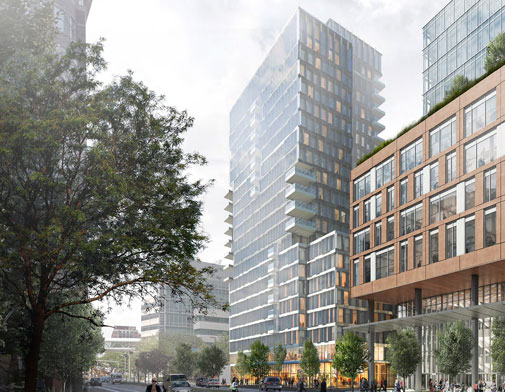Do “Area Plans” Harm Affordability? The Case for City-Wide Upzonings

Shane Phillips at the UCLA Lewis Center for Regional Policy Studies analyses the relationship between land values and upzoning in a new essay, “Building Up the ‘Zoning Buffer’: Using Broad Upzones to Increase Housing Capacity Without Increasing Land Values.” Phillips explores policy strategies for increasing housing production without major shocks to land values that can make current homeowners fear a lack of affordability.
The key concept: If zoning changes allow new multi-family homes to be built in one specific neighborhood – but, importantly, not in others – that neighborhood could see new development potential lead to spikes in land and existing home values, leading to possible displacement. But if zoning is increased broadly throughout a larger area, ideally city- or region-wide, development potential and stability would not be at odds.
Key takeaways:
- Ongoing housing shortages are exacerbated by the historic downzonings of the 1960s and 70s, in which most California cities like Los Angeles drastically reduced their capacity for new homes in order to prevent construction. By contrast, most upzonings since then have been through “area plans” and “spot zonings” that only target small, specific neighborhoods; sometimes, zoning changes are only applied to a single project or lot.
- Cities should aim for broader upzoning to create a large “zoning buffer”—the gap between the current housing stock, and maximum number of potential new homes permitted in the zoning code.
- The larger and broader this buffer, the more affordable housing can be to both new and existing residents. As Philips writes: “When zoning capacity exceeds population by a wide margin, reductions to the cost of construction will benefit people looking to buy or rent a home. When capacity exceeds population by a narrow margin, cost reductions will benefit people who own land.”
Historically, most US cities planned for far more housing than was needed for the existing population. But as cities started to integrate in the post-war era of the 1950s and 60s, a racist backlash ended this practice, and a wave of mass downzonings followed.
The result: Housing is increasingly unaffordable for most households. This was deliberate, as downzonings greatly reduced the “zoning buffer” between current housing stock and the maximum allowable housing capacity. “Before 1960, the buffer in both New York and Los Angeles was at least 300%,” Philips reports. “New York’s fell to roughly 50% after the 1961 zoning update, and it was just 12% in Los Angeles in 2010.”
Proposals to increase zoned capacity have been criticized for potentially causing drastic increases in land prices that would negate the benefit of increased supply. Using recent zoning changes in LA’s Bundy Triangle neighborhood as a case study, Philips outline three basic schools of thought on upzoning: “value capture” policies that aim to condition upzonings on redistribution of potential gains to the public; a “windfall” profit rewarding current property owners who sell for redevelopment; and broad upzoning.
Broad upzoning would increase the zoning buffer the most, and “capture” the value in the form of lower rents and land prices for current and future tenants and homeowners.
The upzoning of Bundy Triangle parcels, itself an expansion of a planned rezoning around the Expo/Bundy rail station finalized in December 2019, saw 16 homes sell for 50-100% more than sale prices listed before the upzoning. Those parcels are now proposed for redevelopment by developer Carmel Partners for 455 new apartment homes, with 52 deed-restricted for extremely low-income households under conditions of the new zoning.
This “value capture” policy essentially assumes, as Phillips puts it, that “windfalls are a price worth paying” for the new housing. But, as Phillips points out, this is predicated on the continued scarcity of housing.
Instead, Phillips proposes “to recognize that land values for the Bundy Triangle properties increased not only because more homes can be built there, but because so few homes can be built elsewhere.” Broad upzoning would be a better approach: “A large zoning buffer allows properties with redevelopment potential to transact at lower prices, ultimately delivering lower-cost housing to residents.”
Phillips explains that these windfalls are a function of market power for the property owners, so a broad upzoning with greater redevelopment capacity spread across the city would reduce the premium they could command.
Furthermore, windfall profits would not be needed to induce redevelopment, since regular turnover in the housing stock would more likely result in redevelopment throughout the city. Both the size and geographic breadth of the zoning buffer are important: Phillips also notes that any effort to “cheat” with their zoning buffers by adding a large amount of capacity to a small area would not see the same affordability benefit.